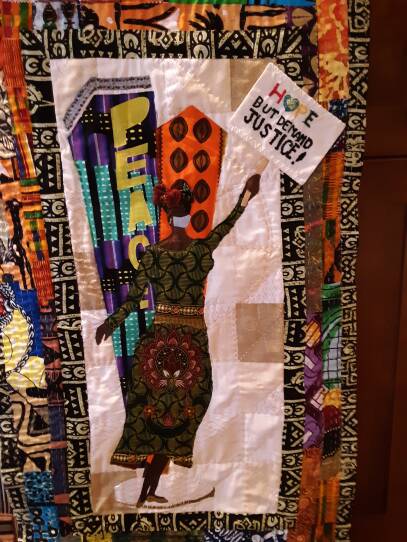On this week’s Joy Beat, we’re celebrating the vibrant legacy of quilting as a powerful storytelling tool, especially in the hands of someone dedicated to telling stories that combine artwork, archive and cultural connection.
Lesyslie Rackard’s bold and expressive quilts tell the incredible and often overlooked stories of Black history — particularly the lives and contributions of African American women. Lesyslie joined GBH’s All Things Considered host Arun Rath to share more about the joy and healing behind the stitch. What follows is a lightly edited transcript.
Arun Rath: First off, I want to talk about pretty much everything you do. But tell us about the different organizations that you’ve worked with to bring this together.
Lesyslie Rackard: I’ve belonged to Sisters in Stitches Joined by the Cloth since 2003. I became a member of the Princeton Sankofa Stitchers, and now, I’m also a member of the Cambridge Modern Quilt Guild.
The thing is that all the guilds bring something different out of me as far as creativity. With Sisters in Stitches, it’s all about the culture and the heritage. With Princeton, it’s all about teaching each other, and we collaborate and bring things together. With Cambridge, it’s all about inclusiveness. DEI [diversity, equity and inclusion] is all over the place — but Cambridge Modern Quilt stands for that. That’s on their platform.
You could choose our next Joy Beat!
If you’d like to nominate someone or something for the Joy Beat, leave us a voicemail at 617-300-BEAT (2328).
Rath: I’ve got to say, I’ve got a geographical bias — I live in Lexington — so I want to talk a little bit more about Sisters in Stitches because their mission, especially, is pretty awesome. You’re telling untold stories.
Rackard: Yes. And that brings in the preserving of the art, this history, the culture, the tradition of African American quilt making. Quilt making is not just for the bed. Now, we bring different forms of art through fiber.
We’re political — when you say “untold stories,” like I have a quilt called “The Laundress” based on my aunt who was a laundress in the 1940s. When you look at that image of her ironing clothes as a means of making a living, you see the movement in what she did as a woman — as an African American woman.

Also, I made a quilt, “Hope,” and it was all about ... during COVID, you know, I couldn’t go out there to marches because of George Floyd. I couldn’t do that, but I made the quilt. “Hope — but be prepared to be uncomfortable.”
That was my niece who was, I think, at the time, 13. She had a poster [that said the quote] standing on the corner in the South End. There’s where the art comes alive and where the art crosses all boundaries.
Rath: For you, personally, when did you realize that you could — through quilting, through fiber — tell these stories? Was there a “eureka” moment at some point?
Rackard: Well, fiber was always there. Sewing was always there. So, I started crocheting.
My sister-in-law and I would go to Woolworth’s downtown and get the yarn and make coats, hats and gloves — you know, because kids will lose their gloves in a heartbeat. No matter what you did, how you attached it to their coat, they’ll still lose their gloves. So, we had to figure out something to keep them warm.
But then, life got in the way, and so I stopped. But then after that, I was making small things — well, it’s called a quillow. And then, it changed again; now, I’ve started making wall quilts. I couldn’t fit it through my sewing machine because my sewing machine was so small!
Making art quilts really started with Sisters in Stitches. We will come together at the table, and we will talk about different issues. It evolved into something just a little different for me. I still like the tradition of making a bed quilt, which is just a bit smaller. But, you know, I like the idea of where I am now, as far as making the art.
“Auntie lived till she was 92. And when she passed away, I thought, ‘What could I do to help remember her the most?’ What I did was I took one of her dresses, and I incorporated it into the quilt itself.”Lesyslie Rackard
Rath: I’ve read that you’ve described quilting as both a creative and a healing act. Can you talk about that, especially in the context of these stories that you’re telling?
Rackard: I have to go back to “The Laundress” because Auntie lived till she was 92. And when she passed away, I thought, “What could I do to help remember her the most?” What I did was I took one of her dresses, and I incorporated it into the quilt itself — of her ironing.
On [the quilt] was her with her dress, and she was ironing the quilt, which represented me. On the floor was a laundry basket with a washboard — that brings in my mom, because my mom was the one who would find solace washing clothes in the tub with the washboard, which we still have. In the background is a window with flowers. Auntie would always say, “Don’t buy me flowers when I die. I can’t smell them!”
There’s where the healing is for me, and a means of remembrance for the family, actually.
Rath: You know, this is the Joy Beat. We’re talking about things that are not so joyful in some of these narratives. I’m wondering where you find the most joy in your work.
Rackard: That’s a good question because I think it is the idea of it — the inspiration of it. And then, taking that inspiration and bringing it into the present, as far as what color and how is that design going to develop.
I did a piece called “Oh Freedom, Oh Freedom,” and it was based on the Black patriots in the Revolutionary War. I thought it would be good to bring that into the present to help represent them. And that was a process. How was I going to put that in a visual narrative? How was I going to reflect that so when people saw that quilt, they knew exactly what I was trying to say?
The joy is ... you know, I’ve got to say that I had my grandson help me with that because there were moments when he said, “You know, that’s not symmetrical. You need to make it symmetrical.” And I said, “OK, that’s good.”
There is where the joy comes in as far as creating a piece that somehow might touch someone because it’s different for everybody. Everybody doesn’t see the same thing. How that is going to touch someone and remind them of someone in their life. And then, for them to come and say, “I love this piece. Thank you.”
That brings me joy. That brings me joy.
If you’d like to nominate someone or something for the Joy Beat, leave us a voicemail at (617) 300 - BEAT [2328].








